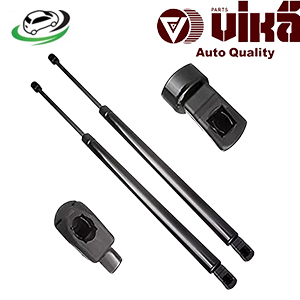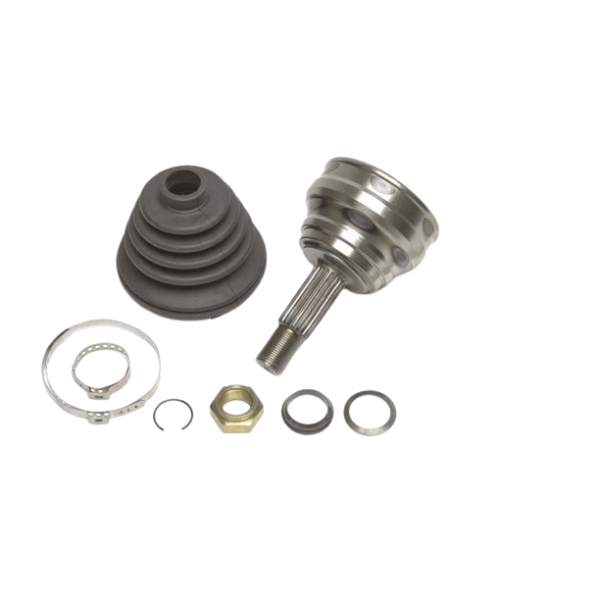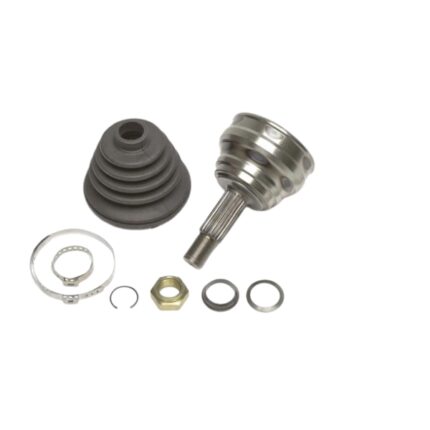Get VW Polo (6N2) Drive Shaft Joint Kit 6N0498099 in Kenya
The drive shaft joint kit, often referred to as a constant velocity (CV) joint kit, is an essential component of a vehicle’s drivetrain system. It plays a vital role in transferring power from the engine to the wheels, allowing the vehicle to move. The drive shaft, which connects the transmission to the wheels, uses CV joints to allow for smooth and consistent power transfer even when the wheels are turning or when the suspension is moving up and down. In this comprehensive guide, we will explore the drive shaft joint kit in detail, including its components, functions, benefits, common issues, maintenance tips, and replacement procedures.
1. The Function of a Drive Shaft Joint Kit
The primary purpose of a drive shaft joint kit is to ensure a smooth transmission of torque from the vehicle’s transmission or differential to the wheels. This occurs while accounting for the changes in angle between the transmission and the wheels, which can happen due to steering or suspension movement. This makes the CV joint crucial for providing flexibility while maintaining power transfer.
Key Functions:
- Power Transmission: The drive shaft joint transfers torque from the engine to the wheels, which enables the vehicle to move forward or backward.
- Flexibility for Steering and Suspension Movement: CV joints allow the drive shaft to bend and flex while maintaining smooth power transmission, making it possible for the wheels to turn and move up and down with the suspension.
- Rotation at High Speeds: CV joints ensure that the wheels can rotate smoothly at various speeds without compromising the vehicle’s handling or performance.
2. Components of a Drive Shaft Joint Kit
A typical drive shaft joint kit consists of several components that work together to facilitate the smooth and efficient transmission of power. Understanding these components is key to understanding how the system works as a whole.
1. Constant Velocity (CV) Joint:
The CV joint itself is the primary component of the kit. There are two types of CV joints commonly used in vehicles:
- Outer CV Joint: Located at the end of the drive shaft that connects to the wheel, the outer CV joint allows the drive shaft to move while accommodating the steering motion of the wheels.
- Inner CV Joint: Found closer to the transmission or differential, the inner CV joint allows the drive shaft to adjust to suspension movement as the wheels move up and down.
2. CV Boot:
The CV boot is a flexible rubber or plastic cover that encases the CV joint. Its primary purpose is to protect the joint from dirt, debris, and moisture, which could cause damage or premature wear.
3. Grease:
CV joints require constant lubrication to function smoothly. Special grease is packed inside the joint and the boot to reduce friction and wear, ensuring the longevity of the joint.
4. Clamps and Clips:
The clamps and clips are used to secure the CV boot to the joint and prevent grease from leaking out. They also keep the boot sealed, protecting the joint from contamination.
5. Drive Shaft:
The drive shaft is the connecting rod that transmits power from the transmission or differential to the wheels. In many cases, the drive shaft is included as part of the CV joint kit, especially if the CV joints are integrated into the shaft itself.
3. Benefits of a Drive Shaft Joint Kit
A well-functioning drive shaft joint kit offers several important benefits for the performance and safety of a vehicle. Here are some of the key advantages:
1. Smooth Power Transfer:
The CV joints ensure that power is transmitted from the engine to the wheels smoothly, regardless of whether the vehicle is turning or the suspension is moving. This is essential for maintaining control and performance.
2. Flexibility for Steering and Suspension:
CV joints allow for the flexibility needed for the wheels to turn or move up and down with the suspension. Without this flexibility, the vehicle would not be able to handle uneven surfaces or cornering effectively.
3. Improved Handling and Comfort:
By providing smooth and continuous power transfer, CV joints help improve the overall handling of the vehicle. This results in better control, smoother rides, and enhanced driver comfort.
4. Reduced Wear on Other Components:
A properly functioning CV joint reduces the strain on other drivetrain components, such as the transmission, differential, and axles. This helps to extend the life of these parts and reduce the need for costly repairs.
5. Longevity:
When properly maintained, CV joints can last a long time, often over 100,000 miles. This makes them a durable and reliable part of the vehicle’s drivetrain system.
4. Common Issues with Drive Shaft Joint Kits
Like any mechanical component, drive shaft joint kits are subject to wear and tear. Over time, various issues can arise that affect the performance of the CV joints. Below are some of the most common problems associated with drive shaft joint kits:
1. CV Boot Damage:
One of the most common issues with CV joints is damage to the CV boot. Since the boot is made of rubber or plastic, it can crack, tear, or degrade over time. A damaged CV boot allows dirt, debris, and moisture to enter the joint, leading to contamination and eventual failure of the joint.
2. Grease Leakage:
If the CV boot is damaged or not sealed properly, grease can leak out of the joint. This results in inadequate lubrication, leading to increased friction and wear on the joint.
3. Clicking or Popping Noise:
A clicking or popping noise, especially when turning, is often a sign of a worn or damaged outer CV joint. This noise indicates that the joint is no longer functioning smoothly and may need to be replaced.
4. Vibration While Driving:
Excessive vibration while driving, particularly at higher speeds, can be a sign of a worn inner CV joint or drive shaft imbalance. This vibration may be felt through the steering wheel or the vehicle’s floor.
5. Loss of Power Transmission:
In extreme cases, a completely worn-out CV joint can fail to transmit power to the wheels, causing the vehicle to lose the ability to move. This typically occurs when the joint is severely damaged or broken.
5. Maintenance Tips for Drive Shaft Joint Kits
Proper maintenance of the drive shaft joint kit is essential to ensure the longevity and performance of the CV joints. Here are some key maintenance tips to keep your drive shaft joint kit in good condition:
1. Regular Inspection:
Regularly inspect the CV boots for signs of damage, such as cracks, tears, or grease leakage. Early detection of boot damage can prevent more serious issues with the CV joint itself.
2. Keep the Joints Lubricated:
Ensure that the CV joints are adequately lubricated by checking for grease leaks. If necessary, reapply the appropriate type of grease to keep the joints functioning smoothly.
3. Avoid Harsh Driving Conditions:
Driving in harsh conditions, such as off-road or in areas with a lot of dirt, debris, or water, can accelerate wear on the CV joints. Try to avoid these conditions when possible, or inspect the joints more frequently if driving in such environments.
4. Replace Damaged Boots Immediately:
If you notice any damage to the CV boot, replace it immediately to prevent contamination of the joint. Even a small tear can allow dirt and moisture to enter, leading to joint failure.
6. Replacing a Drive Shaft Joint Kit
If a CV joint or boot is damaged beyond repair, it will need to be replaced to ensure the safe operation of the vehicle. Replacing a drive shaft joint kit can be done at home with the right tools and knowledge, or by a professional mechanic. Below is an overview of the replacement process:
1. Gather Necessary Tools and Parts:
Before starting, gather the necessary tools, such as a socket wrench set, pliers, and possibly a pry bar. You’ll also need the new CV joint kit or boot and any grease or clamps that may be required.
2. Jack Up the Vehicle:
Safely lift the vehicle using a jack and secure it with jack stands. Make sure the vehicle is stable before working under it.
3. Remove the Wheel:
Remove the wheel on the side where the CV joint will be replaced to gain access to the drive shaft.
4. Remove the Drive Shaft:
Disconnect the drive shaft from the transmission or differential, and carefully remove it from the vehicle. This may involve removing other components, such as the axle or suspension parts, to access the drive shaft.
5. Replace the CV Joint or Boot:
If only the boot is damaged, you can replace it by removing the old boot, cleaning the joint, applying new grease, and installing the new boot with clamps. If the joint itself is damaged, the entire CV joint will need to be replaced.
6. Reassemble and Test:
Once the new joint or boot is installed, reassemble the drive shaft and other components, reinstall the wheel, and lower the vehicle. Test drive the vehicle to ensure that the new joint is functioning properly.
Conclusion
The drive shaft joint kit is a crucial component of a vehicle’s drivetrain, ensuring smooth power transfer from the engine to the wheels while allowing for the flexibility needed for steering and suspension movement. Regular maintenance, timely inspections, and proper care of the CV boots and joints are essential for maintaining the performance and longevity of this vital system. By understanding its components, benefits, common issues, and replacement procedures, vehicle owners can keep their drive shaft joints in optimal condition, ensuring a smooth and safe driving experience.
Follow us on Facebook for more parts.





Reviews
Clear filtersThere are no reviews yet.